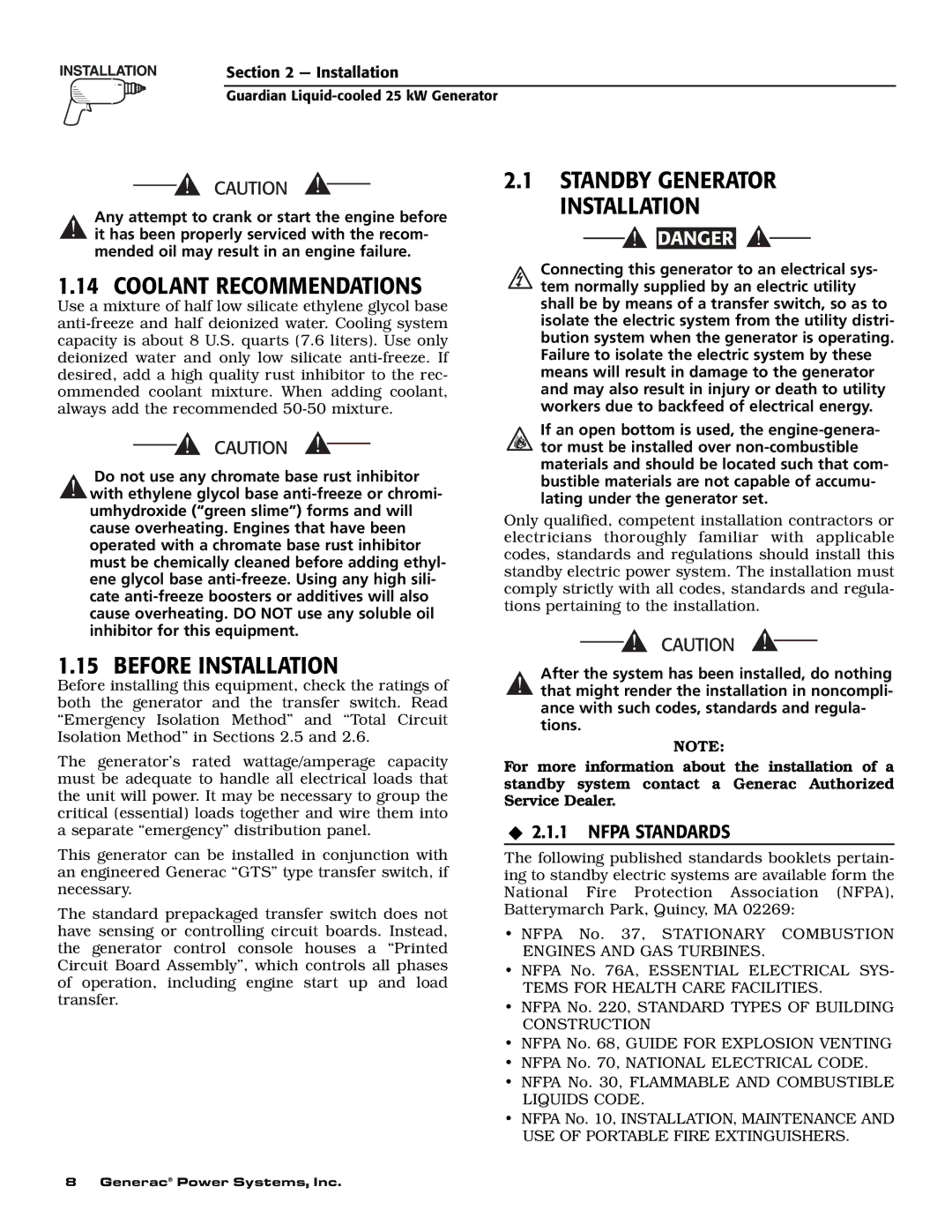
Section 2 — Installation
Guardian
Any attempt to crank or start the engine before
!it has been properly serviced with the recom- mended oil may result in an engine failure.
1.14 COOLANT RECOMMENDATIONS
Use a mixture of half low silicate ethylene glycol base
Do not use any chromate base rust inhibitor
!with ethylene glycol base
2.1STANDBY GENERATOR INSTALLATION
![]()
![]() DANGER
DANGER
Connecting this generator to an electrical sys- tem normally supplied by an electric utility shall be by means of a transfer switch, so as to isolate the electric system from the utility distri- bution system when the generator is operating. Failure to isolate the electric system by these means will result in damage to the generator and may also result in injury or death to utility workers due to backfeed of electrical energy.
If an open bottom is used, the
Only qualified, competent installation contractors or electricians thoroughly familiar with applicable codes, standards and regulations should install this standby electric power system. The installation must comply strictly with all codes, standards and regula- tions pertaining to the installation.
1.15 BEFORE INSTALLATION
Before installing this equipment, check the ratings of both the generator and the transfer switch. Read “Emergency Isolation Method” and “Total Circuit Isolation Method” in Sections 2.5 and 2.6.
The generator’s rated wattage/amperage capacity must be adequate to handle all electrical loads that the unit will power. It may be necessary to group the critical (essential) loads together and wire them into a separate “emergency” distribution panel.
This generator can be installed in conjunction with an engineered Generac “GTS” type transfer switch, if necessary.
The standard prepackaged transfer switch does not have sensing or controlling circuit boards. Instead, the generator control console houses a “Printed Circuit Board Assembly”, which controls all phases of operation, including engine start up and load transfer.
After the system has been installed, do nothing
!that might render the installation in noncompli- ance with such codes, standards and regula- tions.
NOTE:
For more information about the installation of a standby system contact a Generac Authorized Service Dealer.
2.1.1 NFPA STANDARDS
The following published standards booklets pertain- ing to standby electric systems are available form the National Fire Protection Association (NFPA), Batterymarch Park, Quincy, MA 02269:
•NFPA No. 37, STATIONARY COMBUSTION ENGINES AND GAS TURBINES.
•NFPA No. 76A, ESSENTIAL ELECTRICAL SYS-
TEMS FOR HEALTH CARE FACILITIES.
•NFPA No. 220, STANDARD TYPES OF BUILDING CONSTRUCTION
•NFPA No. 68, GUIDE FOR EXPLOSION VENTING
•NFPA No. 70, NATIONAL ELECTRICAL CODE.
•NFPA No. 30, FLAMMABLE AND COMBUSTIBLE LIQUIDS CODE.
•NFPA No. 10, INSTALLATION, MAINTENANCE AND USE OF PORTABLE FIRE EXTINGUISHERS.
8 Generac® Power Systems, Inc.
